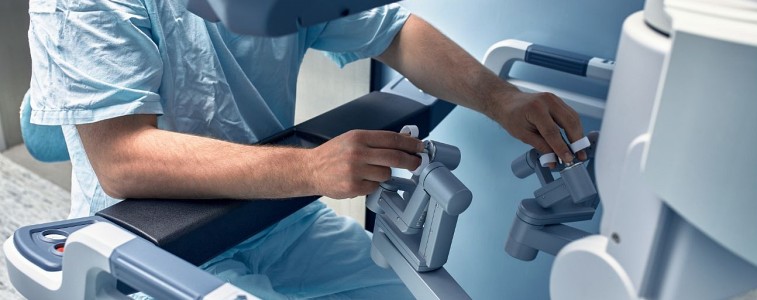December 19, 2024, Robotic-Assisted HoLEP Procedure: by Andromeda Surgery performed in Santiago Chile. From the morningstar.com news article December 19, 2024.
Advances in Prostate Surgery
The field of urology has witnessed a significant breakthrough with the introduction of robotic-assisted holmium laser enucleation of the prostate (RoLEP). This innovative procedure combines the established benefits of HoLEP with cutting-edge robotic technology, potentially revolutionizing the treatment of benign prostatic hyperplasia (BPH).
RoLEP represents a notable evolution in minimally invasive prostate surgery. The procedure utilizes a holmium laser to precisely remove enlarged prostate tissue, while robotic assistance enhances the surgeon’s control and accuracy. This combination aims to address the steep learning curve associated with traditional HoLEP, which has been a limiting factor in its widespread adoption.
Key features of RoLEP include:
- Tablet-based interface for surgeon control
- Integration with existing surgical tools
- Enhanced visualization of anatomical landmarks
- Potential for reduced operative time
RoLEP was developed by Andromeda Surgery from SanFrancisco
About Andromeda Surgical
Andromeda Surgical is a South San Francisco, California-based company developing autonomous surgical robots, starting with endourology procedures. The company’s vision is to make the difficult parts of surgery easy and empower every surgeon to deliver optimal patient outcomes in every procedure. The team combines expertise from medtech, autonomous vehicles, and other robotics and AI applications, working in conjunction with top global urologists.
RoLEP may significantly impact BPH treatment by:
- Expanding access to HoLEP procedures
- Improving surgical outcomes
- Reducing the learning curve for urologists
- Potentially decreasing complications
Compared to other BPH treatments such as transurethral resection of the prostate (TURP) or open prostatectomy, RoLEP offers several potential advantages:
| Aspect | RoLEP | TURP | Open Prostatectomy |
|---|---|---|---|
| Invasiveness | Minimally invasive | Minimally invasive | Invasive |
| Blood loss | Minimal | Moderate | Significant |
| Hospital stay | Short | Moderate | Longer |
| Recovery time | Faster | Moderate | Slower |
| Prostate size limitation | No limit | Limited efficacy for large prostates | No limit |
What Exactly is HoLEP
HoLEP (Holmium Laser Enucleation of the Prostate) is where all possible glandular tissue is removed.
Holmium laser enucleation of the prostate (HoLEP)A minimally invasive procedure that uses a laser to remove prostate tissue that blocks urine flow. HoLEP can remove more tissue than other procedures and can help with bladder obstruction. Patients may need to stay in the hospital overnight, and may experience temporary urinary incontinence and retrograde ejaculation.
From Google Search AI results
Robotic Assisted HoLEP – RoLEP
The introduction of robotic assistance in HoLEP procedures helps to address several challenges associated with the traditional technique:
- Improved Precision: Robotic systems enhances the surgeon’s ability to navigate complex anatomical structures.
- Reduced Fatigue: Automation of certain aspects of the procedure should decrease surgeon fatigue during lengthy operations.
- Standardization: Robotic guidance could help standardize the procedure across different operators.
- Data Collection: Integration of robotic systems may facilitate better data collection for research and quality improvement.
Note: As with any new surgical technique, rigorous clinical trials are essential to evaluate the safety and efficacy of RoLEP. The ASTRA clinical trial, currently underway, aims to provide valuable data on patient outcomes, operative parameters, and learning curve reduction.
Urologists specializing in BPH treatment are optimistic about the potential of RoLEP to address key limitations of current surgical approaches. The ability to perform complex procedures with greater ease could lead to more widespread adoption of laser enucleation techniques, potentially benefiting a larger number of patients suffering from BPH.
The Future
Future developments in RoLEP technology may include:
- Integration of artificial intelligence for real-time surgical guidance
- Expansion to other urological procedures
- Further refinement of the user interface for enhanced surgeon control
As research progresses, it will be crucial to assess long-term outcomes, cost-effectiveness, and patient satisfaction with RoLEP compared to established BPH treatments. The potential for this technology to improve quality of life for BPH patients while reducing the burden on healthcare systems is significant.
The surgical community eagerly anticipates further results from ongoing trials and the possibility of broader implementation of RoLEP in clinical practice. This innovative approach to prostate surgery represents a promising step forward in the treatment of BPH, potentially offering patients improved outcomes with reduced surgical risks.
Common Questions About Robotic-Assisted HoLEP
Comparing Robotic HoLEP to TURP: Outcomes and Recovery
Robotic-assisted HoLEP generally offers several advantages over TURP. Patients typically experience less blood loss, shorter hospital stays, and quicker recovery times. The procedure allows for treatment of larger prostates and often results in more complete tissue removal. However, TURP may still be preferred in certain cases based on individual patient factors and surgeon expertise.
Recovery Expectations After Robotic HoLEP
Post-surgery, patients can expect:
- Mild discomfort for a few days
- Urinary urgency and frequency for 1-2 weeks
- Gradual improvement in urinary symptoms over 4-6 weeks
- Return to normal activities within 1-2 weeks
Patients are usually advised to avoid heavy lifting and strenuous exercise for about 2-4 weeks.
Potential side effects include:
- Temporary urinary incontinence
- Mild burning sensation during urination
- Light blood in urine for a few weeks
- Retrograde ejaculation
Most side effects are temporary and resolve within a few weeks to months.
Robotic HoLEP as an Outpatient Procedure
Robotic HoLEP can often be performed as an outpatient procedure, depending on:
- Patient’s overall health
- Prostate size
- Surgical complexity
- Hospital protocols
Common Side Effects of Robotic HoLEP
Some patients may require an overnight stay for observation, particularly those with larger prostates or additional health concerns.
Long-Term Outlook After Robotic HoLEP
The long-term prognosis for patients undergoing robotic HoLEP is generally positive. Most men experience:
- Significant improvement in urinary symptoms
- Reduced need for BPH medications
- Lower risk of BPH-related complications
- Sustained improvement in quality of life
Long-term studies have shown durable results with low rates of retreatment needed.
Assessing Safety and Success of Robotic HoLEP
Medical professionals evaluate robotic HoLEP through:
- Clinical outcome measures (e.g., urinary flow rates, post-void residual volume)
- Patient-reported symptom scores
- Complication rates
- Reoperation rates
Studies have demonstrated high success rates and safety profiles comparable to or better than traditional surgical approaches for BPH.

